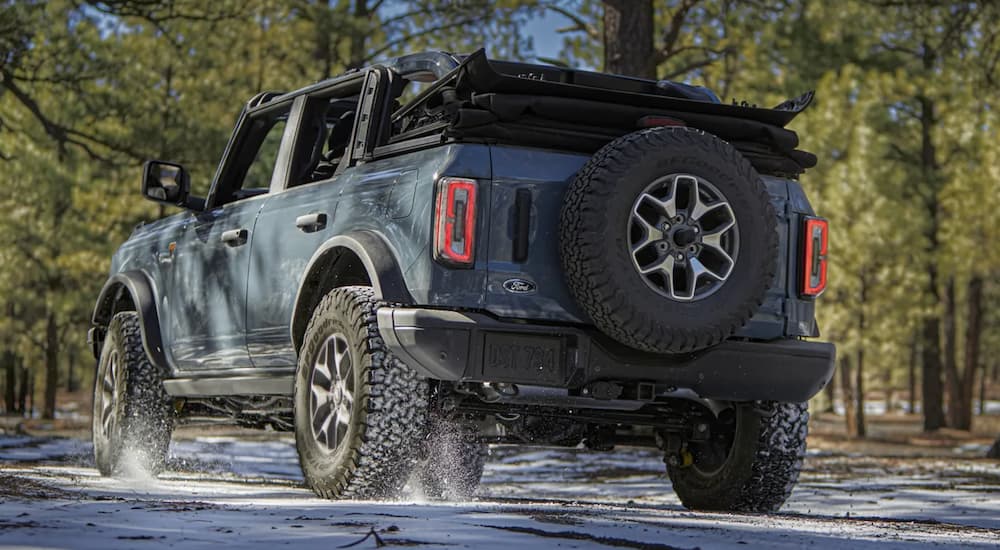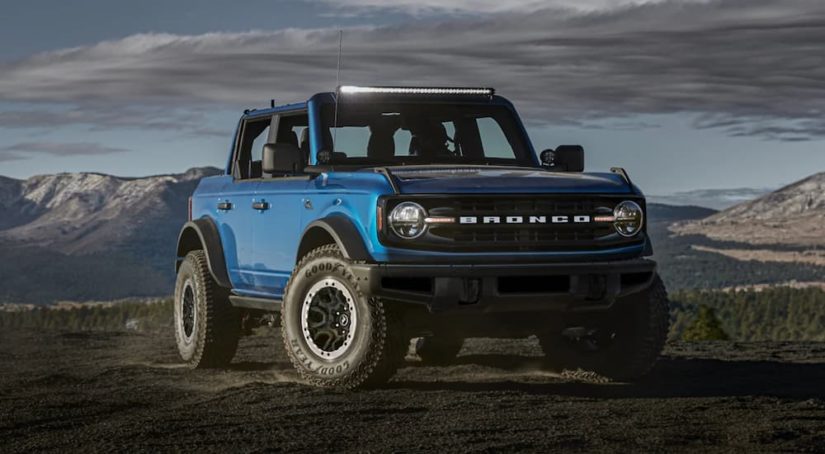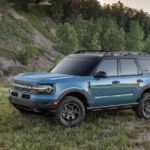Ford fans went wild with excitement when the American automaker announced the return of the iconic Bronco to the lineup in 2021. The announcement coincided with the debut of the all-new 2021 Bronco Sport, which is a smaller version of the Bronco that’s left many drivers wondering about the differences between the two models beyond their size. Since the Bronco has yet to arrive at any Ford Bronco dealership, comparing the models in terms of build, capability, and features is the best way to determine which model suits you and your needs better. Let’s get started!
Design and Build
Affectionately known as the “Baby Bronco,” the Bronco Sport is a conventional SUV that shares the same unibody chassis as the Ford Escape. It sits higher than the Escape and features a more rugged design that gives you the confidence to venture off the pavement, which you likely wouldn’t attempt in the Escape. In contrast, the Bronco is a truck-based SUV that’s based on Ford’s best-selling Ranger truck. This gives the Bronco more capability than the Sport and a much larger platform to work with both on and off the trail.
The different builds are responsible for the size difference between the Bronco and the Bronco Sport. The Bronco Sport might be the “baby” of the two, but it measures between the two-door and four-door Bronco with a 105.1-inch wheelbase. The two-door Bronco measures 100.4 inches, and the four-door Bronco measures 116.1 inches. You’ll see more drastic size differences when you compare length and height since the Bronco Sport measures much smaller than the two-door Bronco. For example, the Bronco Sport stretches 172.7 inches long and up to 74.4 inches tall, while the two-door Bronco is larger at 174.8 inches long and 79.3 inches tall.
The Bronco’s larger size also gives way to a more immersive driving experience in what Ford calls “Max Air,” which you won’t find on the smaller Sport. The Bronco is available with three hard and soft top designs that can be configured in a variety of ways, whether you want the roof fully open, partially open, or fully closed. The Bronco’s doors are also removable and can be conveniently stored in the back of the four-door model. These features also led to the debut of the industry’s first-ever waterproof marine-grade vinyl upholstery and rubberlike flooring with drains that make cleaning the interior as simple as washing it out with a hose.

Powertrain
Since it’s built on the Escape platform, it’s no surprise that the Bronco Sport shares the Escape’s two engine options that are paired with an 8-speed automatic transmission. The base engine is a 1.5-liter EcoBoost three-cylinder that delivers 181 horsepower and 190 lb-ft of torque. For best-in-class power, you’ll want to opt for the Bronco Sport Badlands or First Edition trims that are outfitted with the 2.0-liter EcoBoost four-cylinder that produces 250 horsepower and 275 lb-ft of torque. These trims also come with SelectShift technology that gives you more control both on and off-road by mounting paddle shifters to the steering wheel.
You’ll enjoy even more power in the Bronco that offers either a class-exclusive 7-speed manual transmission with a low granny gear first ratio or a 10-speed automatic transmission paired with either a 2.3-liter or 2.7-liter engine. The 2.7-liter twin-turbocharged EcoBoost V6 delivers best-in-class horsepower at 310 ponies and an exceptional torque rating of 400 lb-ft. The 2.3.-liter turbocharged EcoBoost four-cylinder engine isn’t as beefy but still delivers plenty of power at 270 horsepower and 310 lb-ft of torque.
Four-Wheel Drive
When it comes to off-road capability, you’ll go further on the trail in the Bronco than you will in the Bronco Sport. This capability comes from the Bronco’s exceptional four-wheel drive technology that’s offered as two different systems. The base Bronco is outfitted with the same two-speed electric shift-on-the-fly transfer case that’s found on the F-150. This setup gives you a nice range from 2HI and 4HI to 4LO and neutral.
For better capability, you’ll want the advanced two-speed electromechanical transfer case that automatically shifts between 2H and 4H as needed. Both 4WD systems are paired with Ford’s HOSS or High-Performance Off-Road Stability Suspension system that firmly plants the Bronco on the ground by tuning the springs, shocks, and rear axle. The advanced HOSS also adds Bilstein Position-Sensitive Dampers and an independent front suspension for better handling.
You won’t find the same advanced 4WD systems on the Bronco Sport, which is to be expected from the “Baby Bronco.” Instead of transfer cases, the Sport is equipped with power takeoff units that boost the smaller SUV’s capability off-road. However, you won’t find anything comparable to the Bronco’s low gear range.
Despite this absence, Ford equips the Sport with an independent front and rear suspension that makes the SUV easy to handle and control on rugged terrain. This capability goes even further on the Badlands and First Edition trims that feature tuned front struts, monotube rear shocks, softer springs, and anti-roll bars that make climbing obstacles and navigating bumpy terrain a breeze.
While the 4WD systems are drastically different, the Bronco and Bronco Sport share Ford’s exclusive G.O.A.T. (Goes Over Any Type of Terrain) Modes that allow you to customize how the SUVs perform in a variety of conditions. When you’re navigating the pavement, you can alternate between Normal, Eco, and Sport whether you’re looking to maximize power, efficiency, or sport-like handling. Slippery improves traction in rain and snowy conditions, while Baja, Mud/Ruts, and Rock Crawl are ideal when you’re navigating obstacles on the trail.

Tech and Connectivity
While the Bronco Sport and the Bronco may not have many similarities in terms of powertrains, design, and four-wheel drive systems, they share Ford’s innovative technology that’s designed to keep you connected. The heart of this technology is Ford’s SYNC 3 system that allows you to sync your smartphone using Apple CarPlay or Android Auto. Through the system, you’ll have access to a variety of in-vehicle apps as well as SiriusXM satellite radio and Ford+Alexa, the latter of which allows you to stream your favorite music, listen to a podcast, or add items to your Amazon shopping list with a simple voice command.
Innovation extends from the Bronco and Bronco Sport’s connectivity features to its suite of safety and driver-assist tools known as the Ford Co-Pilot 360 suite. The suite is designed to give you all the confidence you need to operate the SUVs by enhancing your visibility and minimizing the potential for front, rear, and side collisions. For example, Pre-Collision Assist with Automatic Emergency Braking works with Pedestrian Detection, Forward Collision Warning, and Dynamic Brake Support to bring the SUVs to a complete stop if a collision is imminent. The Blind Spot Information System (BLIS) with Cross-Traffic Alert keeps an eye out for vehicles in your blind spots, while the Lane-Keeping System helps you keep the Bronco or the Sport centered in its lane.
The SUVs are also equipped with standard rear view cameras that give you a clear view behind the vehicles. When you upgrade to the Co-Pilot360 Assist 2.0 suite, you’ll get advanced tools like Intelligent Adaptive Cruise Control with Stop and Go, Lane Centering, and Speed Sign Recognition. The Bronco adds a few more features to its suite to improve the Bronco’s stability and your control using tools like Trailer Sway Control and AdvanceTrac with Roll Stability Control.
Bronco vs Bronco Sport: Which Will You Choose?
The Bronco Sport and the Bronco are two of the most highly anticipated vehicles to hit American roads in 2021. While the Bronco hasn’t yet made its arrival, the Bronco Sport is already off to a stellar start and has proven its agility and capability on the trail courtesy of Ford’s four-wheel drive systems and its powerful engines. Of course, the Bronco Sport isn’t designed to venture as far off the trail as the Bronco itself, which is one factor to consider when choosing between the two.
If you’re looking for the ultimate off-road adventure that takes you up and down steep grades, over rocks, and through deep mud pits, then you’ll want to hold out for the extremely capable Bronco. However, if you’re looking for a light-duty rig that can navigate a dirt road with ease and look good doing it, then the Bronco Sport is a great option. Whatever you choose, know that you’re getting a great vehicle that carries the stellar reputation of reliability, capability, and ruggedness of the Ford brand.



